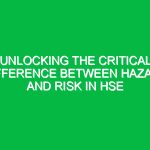Introduction
In the realm of Health, Safety, and Environment (HSE), understanding the term “definition chemical” is paramount. This term encompasses a broad spectrum of substances that pose potential Hazards in various industries, including manufacturing, healthcare, and construction. The definition of chemicals within the HSE context refers to any chemical compound or mixture that can affect human health, safety, or the environment. As industries evolve, so do the chemicals involved, necessitating a comprehensive grasp of their implications to safeguard workers and the ecosystem. This article delves deep into the concept of definition chemical, exploring its significance, associated risks, regulatory frameworks, and Best Practices aimed at enhancing Safety and environmental protection.
Understanding Definition Chemical in HSE
The definition chemical can be categorized into various classes, including hazardous chemicals, toxic substances, flammable materials, and environmental pollutants. Each category presents unique challenges and risks. For instance, hazardous chemicals might include solvents, acids, and heavy metals, which can cause adverse health Effects upon exposure. The relevance of understanding these definitions is underscored by the potential for accidents and health issues that arise from improper handling or disposal of chemicals.
Key Concepts Related to Definition Chemical
To appreciate the complexities of definition chemical, it is essential to understand several key concepts:
- Hazard Classification: Chemicals are classified based on their physical and health Hazards. The Globally Harmonized System (GHS) provides a standardized approach to classifying and labeling chemicals, ensuring that their dangers are communicated effectively.
- Material Safety Data Sheets (MSDS): These documents provide critical information about chemicals, including their properties, hazards, handling, and emergency measures. Familiarity with MSDS is crucial for anyone working with chemicals.
- Exposure Limits: Regulatory agencies establish permissible exposure limits (PELs) to protect workers from harmful effects of chemicals. Understanding these limits is vital for maintaining a safe workplace.
- Risk Assessment: This process involves identifying hazards associated with chemicals, evaluating the potential impact on health and safety, and implementing measures to mitigate risks.
The Importance of Definition Chemical in HSE
Recognizing the significance of definition chemical in HSE is crucial for various reasons:
- Worker Safety: Understanding the chemicals present in the workplace helps in enforcing Safety Measures to protect workers from potential exposure.
- Environmental Protection: Proper management of chemicals prevents environmental degradation, safeguarding ecosystems from pollutants.
- Regulatory Compliance: An awareness of chemical definitions and classifications ensures compliance with local, national, and international Regulations, minimizing legal risks.
Potential Hazards and Risks Associated with Definition Chemical
Exposure to definition chemicals can lead to various health and safety hazards. Common risks include:
- Toxicity: Many chemicals are toxic and can cause immediate or chronic health effects, including respiratory issues, skin irritation, or organ damage.
- Flammability: Chemicals classified as flammable can ignite easily, posing fire hazards in workplaces.
- Corrosiveness: Corrosive chemicals can damage human tissues and equipment, leading to severe injuries and financial losses.
- Environmental Impact: Improper disposal of chemicals can contaminate soil and water, affecting wildlife and human health.
Real-Life Examples of Chemical Hazards
To illustrate the importance of understanding definition chemical, consider the case of a manufacturing facility that improperly stored solvents. The lack of proper labeling led to a worker accidentally mixing incompatible chemicals, resulting in a violent reaction that caused injuries and significant property damage. This incident underscores the necessity for clear definitions and classifications in HSE practices.
Another example involves the healthcare sector, where chemicals such as disinfectants and pharmaceuticals pose risks if not handled correctly. A hospital’s failure to educate staff about the hazards associated with certain cleaning agents resulted in several cases of respiratory distress among employees, highlighting the need for comprehensive Training and risk management strategies.
Best Practices for Managing Definition Chemical
Implementing Best Practices for handling chemicals is essential for mitigating risks associated with definition chemical. Here are some actionable guidelines:
- Training and Education: Regular training sessions for employees on Chemical Safety, including understanding MSDS and proper handling techniques, can significantly reduce the risk of accidents.
- Proper Labeling and Storage: Ensure all chemicals are labeled accurately and stored in designated areas to prevent unauthorized access and accidental exposure.
- Emergency Preparedness: Develop and communicate emergency response plans specific to chemical spills or exposures, ensuring all employees are familiar with Procedures.
- Regular Inspections: Conduct routine inspections of chemical storage areas and usage practices to identify potential hazards and enforce compliance with safety Standards.
Regulations and Standards Governing Definition Chemical
The regulation of definition chemical is multifaceted, involving various local, national, and international laws aimed at ensuring safety and environmental protection. Some key regulations include:
- Occupational Safety and Health Administration (OSHA): osha sets forth standards for the safe handling and use of hazardous chemicals in the workplace, including requirements for labeling and employee training.
- Environmental Protection Agency (EPA): The EPA regulates chemicals that can harm the environment, enforcing laws that govern their use, storage, and disposal.
- REACH (Registration, Evaluation, Authorisation, and Restriction of Chemicals): This European Union regulation addresses the production and use of chemical substances, ensuring safety in the supply chain.
Understanding and complying with these regulations is crucial for organizations to avoid penalties and ensure the safety of their employees and the environment.
Conclusion
In summary, the concept of definition chemical is intricately linked to health, safety, and environmental Sustainability. A thorough understanding of the risks associated with various chemicals, coupled with adherence to safety regulations and best practices, is essential for protecting workers and the ecosystem. As industries continue to evolve, so too must our approaches to managing chemicals. By prioritizing education, compliance, and proactive measures, we can create safer workplaces and a healthier environment for all. As we move forward, it is essential for individuals and organizations alike to remain vigilant and informed about the chemicals they encounter, ensuring that safety remains at the forefront of their operations.


